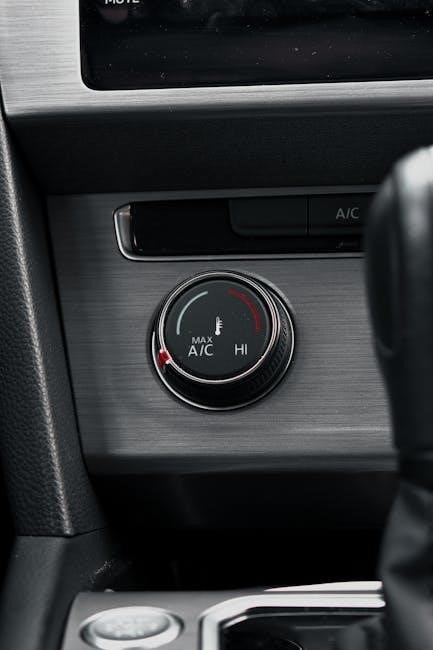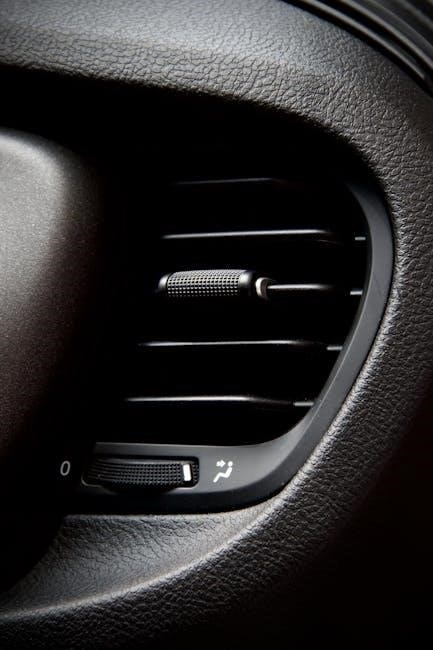Amana offers high-quality, energy-efficient HVAC solutions, providing reliable heating and cooling for residential and commercial spaces. Their systems are designed for durability and optimal performance, ensuring comfort and efficiency.
Overview of Amana Brand and Its History
Amana, founded in 1934, is a trusted name in the HVAC industry, renowned for its innovative and high-quality heating and air conditioning systems. With nearly a century of experience, the brand has built a reputation for reliability, energy efficiency, and cutting-edge technology. Known for its durable products, Amana offers a wide range of solutions for both residential and commercial spaces. The brand has consistently prioritized customer comfort and sustainability, making it a preferred choice for homeowners and businesses. Amana’s legacy is rooted in its commitment to excellence, ensuring that its systems meet the highest standards of performance and efficiency. This heritage is reflected in its comprehensive manuals, which guide users and technicians in optimizing system use and maintenance.
Amana HVAC systems are known for their energy efficiency, durability, and advanced features; They offer a wide range of models, including central air systems, ductless mini-splits, and portable units, catering to various residential and commercial needs. Key features include high SEER ratings for improved energy savings, quiet operation, and reliable performance. Many models come with smart thermostats and Wi-Fi compatibility, allowing for seamless temperature control. Additionally, Amana systems are designed with eco-friendly refrigerants and robust construction, ensuring long-lasting performance. Their user-friendly designs and comprehensive manuals make installation, maintenance, and troubleshooting straightforward. These features collectively enhance comfort and reduce energy costs, making Amana a top choice for HVAC solutions. Proper installation and maintenance are critical for optimal performance of Amana HVAC systems. Improper installation can lead to reduced efficiency, higher energy bills, and system breakdowns. Following Manual J and Manual D standards ensures accurate sizing and ductwork design, maximizing system performance. Regular maintenance tasks, such as air filter replacement and coil cleaning, prevent issues like high head pressure and ensure energy efficiency. A well-maintained system lasts longer and operates more reliably. Local HVAC professionals play a key role in ensuring installations meet these standards, while homeowners must commit to routine upkeep. Proper care extends the system’s lifespan and maintains warranty validity, ensuring consistent comfort and savings. The Amana manual provides essential guidance for users and technicians, covering installation, operation, and troubleshooting. It ensures safe and efficient system operation and maintenance. The Amana heating and air conditioning manual is structured to provide clear, detailed information for users and technicians. It typically begins with an index or table of contents, followed by sections on installation, operation, maintenance, and troubleshooting. The manual includes technical specifications, safety precautions, and diagrams to help users understand system components and proper usage. Key sections cover diagnostic procedures, error codes, and repair guidelines, ensuring efficient problem-solving. Additional resources, such as wiring diagrams and parts lists, are often included for advanced troubleshooting. The manual emphasizes adherence to industry standards like Manual J and Manual D, ensuring installations meet performance and safety requirements. By following the manual, users can optimize system efficiency, extend equipment lifespan, and maintain optimal indoor comfort. To navigate the Amana HVAC manual effectively, start by reviewing the table of contents or index to quickly locate specific sections. Pay attention to key chapters like installation, operation, and troubleshooting, which are essential for understanding system functionality. Use the technical specifications and safety guidelines to ensure proper usage and maintenance. Refer to diagrams and wiring schematics for visual guidance, especially when dealing with complex components. For troubleshooting, focus on error codes and diagnostic procedures to identify and resolve issues efficiently. Always cross-reference your model number with the manual to ensure accuracy. Familiarize yourself with the troubleshooting sections and wiring diagrams for seamless navigation. Regularly check the manual for updates or additional resources available online to maximize your understanding and system performance. The Amana HVAC manual contains crucial sections that every user should familiarize themselves with for optimal system performance. Begin with the installation guide to ensure proper setup, followed by the operating instructions for daily use. The maintenance section outlines essential tasks to uphold efficiency and longevity. Troubleshooting guides are invaluable for diagnosing and resolving common issues, while technical specifications provide detailed information about your specific model. Additionally, the safety precautions section is vital to prevent accidents and ensure safe operation. Regularly reviewing these key areas will empower users to manage their HVAC system effectively and address problems promptly. Always refer to the manual for model-specific details and updates. Proper installation is critical for optimal performance. Adherence to Manual J and Manual D ensures accurate sizing and duct design. Correct installation practices guarantee efficiency and reliability. Manual J and Manual D are critical guidelines for HVAC installation, ensuring systems meet specific load calculations and duct design requirements. Manual J focuses on heating and cooling load calculations, determining the exact needs of a space. Manual D provides detailed duct sizing and design specifications to ensure proper airflow and efficiency. Adherence to these standards guarantees optimal performance, energy efficiency, and system longevity. Installing without these guidelines can lead to poor performance, increased energy bills, and potential system failure. Proper implementation of Manual J and D ensures the HVAC system operates as intended, providing reliable comfort and meeting energy efficiency standards. These manuals are essential for achieving a well-designed and functional HVAC system. Proper installation is crucial for ensuring the efficiency, reliability, and longevity of Amana HVAC systems. Key best practices include sizing the system accurately to match the space’s heating and cooling needs, ensuring precise ductwork installation to avoid leaks and airflow issues, and conducting thorough testing post-installation. Correct placement of outdoor units, away from obstacles and in shaded areas, improves performance. Additionally, ensuring proper refrigerant charging and electrical connections is vital. Following these practices minimizes energy waste, reduces operational noise, and prevents premature wear. Local HVAC professionals play a vital role in adhering to these standards, tailoring installations to specific climate and structural requirements for optimal results. Local HVAC professionals are essential for a successful installation, ensuring systems meet Amana’s high standards. They assess specific needs, choose the right equipment, and install it correctly. Their expertise in Manual J and D calculations guarantees proper system sizing and duct design. They handle complex tasks like refrigerant charging and electrical connections, ensuring safety and efficiency. Regular maintenance by these professionals prevents issues and extends system life. They also provide personalized advice, enhancing comfort and energy efficiency. Collaborating with local experts ensures a seamless installation tailored to unique conditions, delivering optimal performance and reliability. Their knowledge and experience are invaluable for maximizing Amana systems’ potential. Amana HVAC systems may experience issues like high head pressure or system shutdowns. The manual reset button is crucial for resolving such problems. Always refer to the manual for guidance. High head pressure in Amana HVAC systems can lead to reduced performance or system shutdown. Common causes include blocked airflows, faulty refrigerant levels, or improper installation. Symptoms may include reduced cooling, strange noises, or increased energy bills. To resolve, ensure proper airflow by cleaning filters and checking ducts. Verify refrigerant levels and address any leaks. If issues persist, consult the manual for specific troubleshooting steps. In severe cases, the system may shut down, requiring the use of the manual reset button. Always refer to the Amana manual for detailed guidance on diagnosing and resolving high head pressure issues effectively. The manual reset button is a crucial feature in Amana HVAC systems, designed to address operational issues. It is typically located on the control board and must be pressed to restart the system after a shutdown. This button is often activated due to high head pressure, power issues, or sensor malfunctions. To reset, turn off power, press and hold the button for 5-10 seconds, then restore power. Improper use can cause further problems, so always follow the manual’s instructions. Resetting should only be done after identifying and addressing the root cause. Regular maintenance and adherence to manual guidelines ensure optimal performance and prevent unnecessary resets. Amana HVAC systems can experience issues like high head pressure, faulty capacitors, or improper air flow. High head pressure often shuts down the system, requiring manual reset and checking for blockages. Faulty capacitors may cause motors to fail, needing replacement by a professional. Air filters should be cleaned or replaced regularly to ensure proper airflow. If the system does not cool or heat, check thermostat settings and ensure proper power supply. Strange noises or leaks indicate potential compressor or refrigerant issues. Always refer to the manual for troubleshooting steps and consult a professional if problems persist. Regular maintenance can prevent many of these issues. Regular maintenance ensures optimal performance of Amana HVAC systems. Clean air filters monthly, inspect ducts for leaks, and schedule annual professional tune-ups to maintain efficiency and extend lifespan. Regular maintenance is crucial for ensuring the efficiency and longevity of Amana HVAC systems. Homeowners should replace air filters monthly to improve airflow and reduce energy consumption. Additionally, inspecting and cleaning condenser coils annually can prevent high head pressure issues. It’s also important to check ductwork for leaks and seal them to maintain optimal performance. Scheduling annual professional tune-ups ensures that all components are functioning correctly. By following these maintenance tasks, users can prevent common issues, reduce energy bills, and extend the lifespan of their Amana HVAC systems. Regular upkeep also helps maintain consistent indoor air quality and comfort. Replacing the air filter in your Amana HVAC system is essential for maintaining its efficiency and performance. A clean filter ensures proper airflow, which prevents dust and debris from damaging the system. It also improves indoor air quality by trapping allergens and pollutants. Regular filter replacement can lower energy bills by reducing the system’s workload. Neglecting this task may lead to higher head pressure, reduced cooling or heating capacity, and increased risk of system failure. Amana recommends replacing filters monthly for optimal results. This simple maintenance step is crucial for extending the lifespan of your HVAC system and ensuring consistent comfort. Always use the correct filter size and type for your specific model. Proper maintenance is key to maximizing the energy efficiency of your Amana HVAC system. Regularly inspect and clean the evaporator and condenser coils to ensure optimal heat transfer. Dirty coils can increase energy consumption and reduce system performance. Additionally, ensure that the thermostat is set to energy-saving modes, such as programmable settings, to regulate temperatures effectively. Insulate ductwork and seal any leaks to prevent energy loss. Scheduled professional tune-ups can also optimize system performance and identify potential issues before they escalate. By maintaining your Amana system, you can enjoy lower utility bills, consistent comfort, and a longer system lifespan. Proper maintenance not only saves energy but also enhances overall efficiency and reliability. Amana HVAC manuals are accessible online, providing detailed instructions for installation, operation, and troubleshooting. Use your model number to download specific guides and technical specifications. To access Amana HVAC manuals, visit their official website and navigate to the “Support” or “Resources” section. Enter your product model number in the search bar to find the corresponding manual. Most manuals are available in PDF format for easy downloading. These documents provide detailed instructions for installation, operation, and troubleshooting. Additionally, they include technical specifications and maintenance tips to ensure optimal performance. For specific models, such as the Amana RCC60A2A, manuals can be downloaded directly from the manufacturer’s portal. Always refer to the official Amana website for the most accurate and up-to-date information. This ensures you have the correct guide for your system. Amana product manuals are essential for diagnosing and resolving common issues with HVAC systems. They provide step-by-step troubleshooting guides and repair instructions tailored to specific models. For example, if a system shuts off due to high head pressure, the manual offers solutions to address this problem. Additionally, manuals include details about components like the run capacitor, helping users identify and replace faulty parts. The manual reset button, a critical feature, is also explained to ensure users can restart their systems safely. By following the manual’s instructions, users can perform routine maintenance and repairs efficiently, minimizing downtime and extending the system’s lifespan. Regular reference to the manual helps users maintain optimal performance and comfort. Amana HVAC systems come with detailed technical specifications that outline performance metrics, such as SEER ratings, AFUE, and tonnage, ensuring users understand their system’s capabilities. The manuals provide essential information about installation requirements, including electrical connections, venting, and compatibility with other components. Technical documents also cover warranty details, maintenance schedules, and safety guidelines. By reviewing product literature, users can identify model-specific features and ensure compliance with industry standards like ENERGY STAR. Understanding these specifications helps users optimize system performance, troubleshoot issues, and adhere to safety protocols. Proper interpretation of technical documents ensures efficient installation, operation, and maintenance, maximizing comfort and energy efficiency while minimizing potential risks. Amana provides detailed guides for popular models like RCC60A2A and AMAP101AW-2, offering tailored installation, operation, and troubleshooting tips. Accessing these resources online ensures optimal performance and user satisfaction. Amana offers a variety of HVAC models designed for efficiency and comfort. The RCC60A2A is a central air conditioning unit known for its reliability and durability, featuring a robust cooling system. The AMAP101AW-2 is a portable air conditioner ideal for flexible cooling solutions in different spaces. Additionally, Amana’s Distinctions series provides advanced features like smart thermostats and energy-saving technology. These models are praised for their performance, with many users highlighting their quiet operation and effective temperature control. Whether for residential or commercial use, Amana’s diverse lineup ensures there’s a system to meet every need, supported by comprehensive manuals for easy installation and maintenance. Each Amana HVAC model comes with detailed instructions tailored to its unique features and operation. For instance, the RCC60A2A central air conditioning unit requires specific installation steps to ensure proper cooling performance. Similarly, the AMAP101AW-2 portable air conditioner includes guidelines for venting and placement to maximize efficiency. These instructions are typically found in the product manual or online resources. Proper installation involves ensuring compatibility with existing ductwork and electrical systems. HVAC professionals often recommend following these guidelines closely to avoid common issues. Additionally, model-specific troubleshooting tips are provided to help users address minor problems independently. Always refer to the official manual for precise instructions tailored to your specific Amana model. Amana HVAC models often have unique troubleshooting requirements. For the RCC60A2A, addressing a faulty run capacitor involves replacing it with the correct specifications. The AMAP101AW-2 portable unit may require checking venting and drainage for proper operation. High head pressure issues can often be resolved by resetting the system using the manual reset button, as outlined in the user manual. For models like the Distinctions series, auxiliary heat settings should activate around 40°F to maintain efficiency. If issues persist, consulting the FAQ section or contacting Amana’s technical support is recommended. Always refer to the specific model’s manual for precise troubleshooting steps to ensure optimal performance and safety. Common questions about Amana HVAC systems include troubleshooting tips, air filter replacement, and optimal settings. Visit the Amana website for detailed answers and guides. FAQs about Amana HVAC systems often revolve around troubleshooting, maintenance, and optimal performance. Users frequently ask about resolving high head pressure issues, understanding the manual reset button, and replacing faulty capacitors. Many inquiries focus on energy efficiency, air filter replacement, and proper installation practices. Others seek advice on selecting the right system size for their homes and understanding the importance of Manual J and D in installation. Additionally, questions about auxiliary heat settings, model-specific features, and where to find detailed product manuals are common. Amana’s customer support and online resources are often highlighted as key sources for addressing these concerns effectively. Technical and operational queries about Amana HVAC systems are addressed through detailed troubleshooting guides and user manuals. High head pressure issues, for instance, often result from improper installation or clogged air filters, which can be resolved by checking system components. The manual reset button is a key feature to understand, as it helps restart the system after a shutdown. Additionally, capacitors and air filters are common replacement parts, with clear instructions provided in the manual. Proper installation following Manual J and D standards ensures optimal performance. Amana’s resources also clarify auxiliary heat settings and energy efficiency tips, providing users with comprehensive solutions to maintain their systems effectively. For additional support, Amana offers a wealth of resources on their official website, including downloadable manuals, troubleshooting guides, and FAQs. Users can access product-specific literature by entering their model number, ensuring they find the most relevant information. Local HVAC professionals also provide expert installation and maintenance services, adhering to Manual J and D standards for optimal system performance. Furthermore, Amana’s customer service team is available to address technical queries, while independent forums and contractor networks offer peer advice and solutions. These resources collectively ensure that users can resolve issues and maintain their systems efficiently, leveraging both official support and community expertise. Amana HVAC systems offer reliable performance and energy efficiency, supported by comprehensive manuals and resources. Proper installation and maintenance ensure optimal functionality, while local professionals provide expert assistance. Amana heating and air conditioning systems are renowned for their reliability, efficiency, and innovative design. Proper installation, adhering to standards like Manual J and D, is crucial for optimal performance. Regular maintenance, including air filter replacement, ensures longevity and energy efficiency. Troubleshooting common issues, such as high head pressure, can often be resolved with the manual reset button. Referencing the user manual provides detailed guidance for operation, repair, and model-specific instructions. Local HVAC professionals play a vital role in ensuring quality installation and addressing technical queries. By following these guidelines, users can maximize the benefits of their Amana HVAC systems and enjoy consistent comfort year-round. Always consult the manual for specific instructions and troubleshooting. To ensure your Amana HVAC system operates efficiently, schedule regular maintenance with a certified technician. Replace air filters every 1-3 months to maintain airflow and reduce energy costs. Always refer to your user manual for model-specific guidance, and use the manual reset button if the system shuts down unexpectedly. During installation, ensure compliance with Manual J and D standards to avoid performance issues. For troubleshooting, consult the manual or contact local HVAC professionals. Proper care and adherence to these tips will extend the lifespan of your system, providing consistent comfort and energy efficiency. Remember, a well-maintained Amana system offers superior performance and reliability. The Amana HVAC manual is a comprehensive guide to understanding and maintaining your system. It provides detailed instructions for installation, operation, and troubleshooting, ensuring optimal performance. By referring to the manual, you can explore advanced features, diagnostics, and maintenance tips tailored to your specific model. This resource helps you identify potential issues early and take corrective actions, preventing costly repairs. Additionally, it outlines safety precautions to ensure proper usage and avoid hazards. Whether you’re a homeowner or a technician, the manual is an invaluable tool for making informed decisions about your HVAC system. Always consult it for precise guidance and to maximize the efficiency of your Amana unit.Key Features of Amana HVAC Systems
Importance of Proper Installation and Maintenance

Understanding the Amana Heating and Air Conditioning Manual
Structure and Content of the Manual
How to Navigate the Manual Effectively
Key Sections Every User Should Know

Installation Standards and Requirements
Manual J and Manual D: Importance in HVAC Installation
Installation Best Practices for Optimal Performance
Role of Local HVAC Professionals in Ensuring Quality Installation

Troubleshooting Common Issues
Identifying and Resolving High Head Pressure Issues
Understanding the Role of the Manual Reset Button
Common Problems and Their Solutions

Maintenance and Upkeep Tips
Regular Maintenance Tasks for Amana HVAC Systems
Importance of Air Filter Replacement
How to Ensure Energy Efficiency Through Proper Maintenance

Product Manuals and Literature
How to Access and Download Amana Manuals Online
Using Product Manuals for Troubleshooting and Repair
Understanding Technical Specifications and Documents

Model-Specific Guides
Popular Amana HVAC Models and Their Features
Model-Specific Instructions for Installation and Use
Troubleshooting Tips for Specific Models

Frequently Asked Questions (FAQs)
Common Questions About Amana HVAC Systems
Answers to Technical and Operational Queries
Where to Find Additional Support and Resources

Final Tips for Optimal Use of Amana HVAC Systems

Encouragement to Refer to the Manual for Detailed Information
